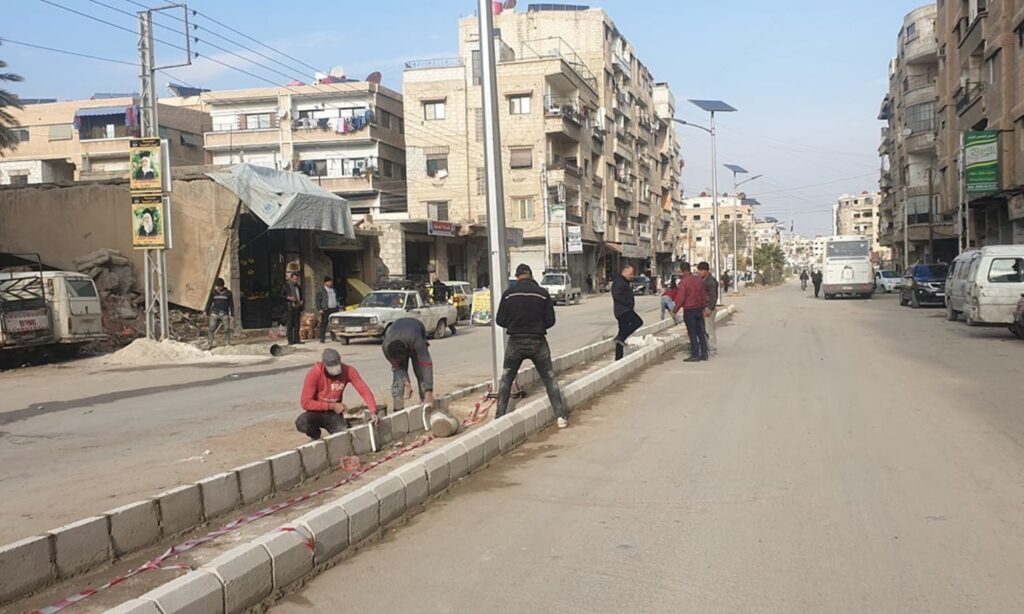The city of Daraya in the countryside of Damascus suffers from a deteriorating service reality, including electricity outages that can last for more than 12 hours compared to just one hour of electricity.
These outages have forced the residents of the area to resort to ampere subscriptions, which entered the capital, Damascus, in mid-2023 before spreading to cities and towns in the eastern Ghouta region, in addition to other towns in the countryside of Damascus.
Long outages
Long hours of power outages and frequent line malfunctions have aggravated the suffering of the residents and prompted them to take repair measures at their own expense.
The area behind the National Hospital in Daraya remained without electricity for several weeks due to a malfunction in the power tank supplying the area after a short circuit, leading to explosions in the transformer.
The residents’ demands to repair the tank were not met, so the cost of maintaining it was collected from the neighborhood’s residents.
Yahya Saeed (pseudonym), a resident of that neighborhood in Daraya, told Enab Baladi, “The power tank remained disabled for about two weeks until we collected the repair costs from the neighborhood’s residents.”
He added that “the electricity shortage puts people in a dilemma, either installing solar energy systems or subscribing to the service of ampere generators, which has reached several neighborhoods in the city center.”
Saeed pointed out that he noticed, through the residents’ demands to restore the electricity, the officials’ lack of interest as they talked about the regularity of the electricity generated by ampere subscriptions and its few malfunctions, which are well monitored.
Ampere subscriptions
The ampere system relies on large diesel generators to supply several neighborhoods or districts for subscribers and install electricity meters to calculate consumption, estimated in kilowatts.
Shareef al-Ahmad (pseudonym for security reasons) from the residents of Daraya city told Enab Baladi that the cost of subscribing to install one meter ranges from 200,000 to 300,000 Syrian pounds, paid once, in addition to purchasing extension lines, while consumption is priced at about 8000 pounds per kilowatt-hour.
The exchange rate of the US dollar surpassed 14,500 Syrian pounds, according to the S-P Today website, which specializes in foreign currency exchange rates.
He explained that the residents are forced to subscribe to this service after months of darkness and giving up most electrical tools, while many cannot switch to the electricity system through solar energy, which costs a minimum of about two million Syrian pounds.
He added, “Despite the high amounts required, the consumer is at the same time able to control the payment time and the amount of consumption.”
Amperes is a widely recognized name for generator electricity in Syria, relied upon by citizens in light of the electricity outages in various Syrian regions, and its price is linked to the price of diesel, which is relied upon by the owners of electricity generators to operate them.
The spread of ampere subscriptions without an official license in Syria is not a recent phenomenon, as it has been relied upon in provinces such as Aleppo, Latakia, and Tartus for years.
The prevalence of the phenomenon in most provinces has been in the interest of specific investors, as amperes trade in Aleppo has been linked to the names of officers in the Fourth Division led by Maher al-Assad, while trade in Latakia province has been linked to Hafez Munther al-Assad, the cousin of the president of the regime, Bashar al-Assad.
The past ten years have significantly exacerbated the service conditions related to electricity in areas controlled by the Syrian regime, where the individual’s share of state electricity consumption has become 15% of what it was in 2010, according to a research study prepared by researchers Sinan Hatahet and Karam Shaar in September 2021.

